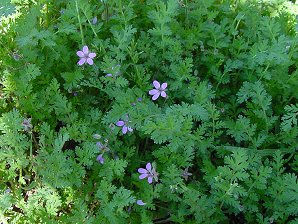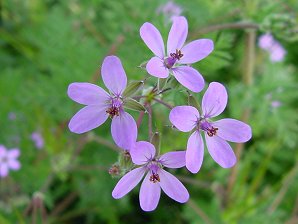Arizona Wild Flowers
Pictures, Photos, Images
Descriptions, Information, Reviews.
Filaree, Erodium cicutarium.
We Are Proud Of Our SafeSurf Rating!
Click On Any Of The Following Links By Amazon.Com
For Books, & Videos About Wildflowers Of Arizona & The Southwest USA. No Obligation!
 |  |
| Filaree (Erodium cicutarium). | Early Source Of Nectar For Honeybees. |
|---|---|
 | |
| Filaree (Erodium cicutarium) A Whole Field Of Filaree. | A Large Field Makes A Large Early Source Of Nectar For Honeybees. |
Filaree.
We wish to thank Wikipedia, the free encyclopedia for some of the information on this page. We share images and information with Wikipedia. An annual, winter annual or biennial. It has a prostrate basal rosette and upright, often leafy flowering stalks. The stalks range from 1/2 inch to about 2 inches high, and originate in the axils of the leaves. The leaves are divided into fine leaflets (or lobes) and are finely dissected, similar to those of a carrot. The flowers are about 1/2 inches across, pink or lavender, and borne on stalks in clusters of 2-12. The sepals of the flowers are somewhat pointed and hairy. The fruiting structure (consisting of the seeds, persistent bristly styles, and central placental axis) is 2-5 cm long and resembles a stork's bill. At maturity, the developing fruit splits into 5 segments, each with a long, spirally twisting style with a seed attached at the base. The style twists hygroscopically, drilling the seed into the soil. Filaree grows worldwide below 70 degrees. It is found in all states except Florida and Louisiana.
Quick Notes:
Height: About 1/2 inch to about 2 inches high.
Flowers: Filaree flowers are about 3/8 inch across, pink or blue - lavender, and borne on stalks in clusters of 2 - 12.
Flowering Time: February through May.
Leaves: Leaves of young plants form a basal rosette. Leaves are finely divided (fern-like), basal, and grow to 4" long.
Fruit: A sharp-pointed, narrow capsule. The point is driven into the ground as it ripens.
Shape: Basal rosette.
Found: Native to the Mediterranean Basin and it was introduced to North America in the eighteenth century,
Hardiness:
Soil pH requirements:
Sun Exposure:
Elevation: Can be found from 0 - 4500 Feet..
Habitat: On cultivated land, roadsides, yards. It also can be found in perennial fields. It prefers well-drained, clayey, loamy, or sandy soil.
Miscellaneous: Flowering Photos Taken February 21, 2003 In Glendale, Arizona.
|
We Are Proud Of Our SafeSurf Rating!
Click On Any Of The Following Links By Amazon.Com
For Books, & Videos About Wildflowers Of Arizona & The Southwest USA. No Obligation!
| © 1966 - Present, Audrey, Eve, & George DeLange |
